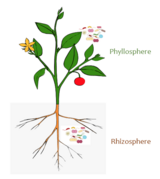
Back ميكروبيوم Arabic Mikrobiom BS Mikrobiom Czech Mikrobiom Danish Mikrobiom German Microbioma Spanish Mikrobioom Estonian میکروبیومها Persian Mikrobiomi Finnish Microbiome French
| Part of a series on |
| Microbiomes |
|---|
 |
A microbiome (from Ancient Greek μικρός (mikrós) 'small', and βίος (bíos) 'life') is the community of microorganisms that can usually be found living together in any given habitat. It was defined more precisely in 1988 by Whipps et al. as "a characteristic microbial community occupying a reasonably well-defined habitat which has distinct physio-chemical properties. The term thus not only refers to the microorganisms involved but also encompasses their theatre of activity". In 2020, an international panel of experts published the outcome of their discussions on the definition of the microbiome. They proposed a definition of the microbiome based on a revival of the "compact, clear, and comprehensive description of the term" as originally provided by Whipps et al., but supplemented with two explanatory paragraphs. The first explanatory paragraph pronounces the dynamic character of the microbiome, and the second explanatory paragraph clearly separates the term microbiota from the term microbiome.
The microbiota consists of all living members forming the microbiome. Most microbiome researchers agree bacteria, archaea, fungi, algae, and small protists should be considered as members of the microbiome. The integration of phages, viruses, plasmids, and mobile genetic elements is more controversial. Whipps's "theatre of activity" includes the essential role secondary metabolites play in mediating complex interspecies interactions and ensuring survival in competitive environments. Quorum sensing induced by small molecules allows bacteria to control cooperative activities and adapts their phenotypes to the biotic environment, resulting, e.g., in cell-cell adhesion or biofilm formation.
All animals and plants form associations with microorganisms, including protists, bacteria, archaea, fungi, and viruses. In the ocean, animal–microbial relationships were historically explored in single host–symbiont systems. However, new explorations into the diversity of microorganisms associating with diverse marine animal hosts is moving the field into studies that address interactions between the animal host and the multi-member microbiome. The potential for microbiomes to influence the health, physiology, behaviour, and ecology of marine animals could alter current understandings of how marine animals adapt to change. This applies to especially the growing climate-related and anthropogenic-induced changes already impacting the ocean. The plant microbiome plays key roles in plant health and food production and has received significant attention in recent years. Plants live in association with diverse microbial consortia, referred to as the plant microbiota, living both inside (the endosphere) and outside (the episphere) of plant tissues. They play important roles in the ecology and physiology of plants. The core plant microbiome is thought to contain keystone microbial taxa essential for plant health and for the fitness of the plant holobiont. Likewise, the mammalian gut microbiome has emerged as a key regulator of host physiology, and coevolution between host and microbial lineages has played a key role in the adaptation of mammals to their diverse lifestyles.
Microbiome research originated in microbiology back in the seventeenth century. The development of new techniques and equipment boosted microbiological research and caused paradigm shifts in understanding health and disease.[1] The development of the first microscopes allowed the discovery of a new, unknown world and led to the identification of microorganisms. Infectious diseases became the earliest focus of interest and research. However, only a small proportion of microorganisms are associated with disease or pathogenicity. The overwhelming majority of microbes are essential for healthy ecosystem functioning and known for beneficial interactions with other microbes and organisms. The concept that microorganisms exist as single cells began to change as it became increasingly obvious that microbes occur within complex assemblages in which species interactions and communication are critical. Discovery of DNA, the development of sequencing technologies, PCR, and cloning techniques enabled the investigation of microbial communities using cultivation-independent approaches. Further paradigm shifts occurred at the beginning of this century and still continue, as new sequencing technologies and accumulated sequence data have highlighted both the ubiquity of microbial communities in association within higher organisms and the critical roles of microbes in human, animal, and plant health. These have revolutionised microbial ecology. The analysis of genomes and metagenomes in a high-throughput manner now provide highly effective methods for researching the functioning of both individual microorganisms as well as whole microbial communities in natural habitats.
- ^ Boctor, Joseph; Oweda, Mariam; El-Hadidi, Mohamed (2023), Mitra, Suparna (ed.), "Comprehensive Guideline for Microbiome Analysis Using R", Metagenomic Data Analysis, vol. 2649, New York, NY: Springer US, pp. 393–436, doi:10.1007/978-1-0716-3072-3_20, ISBN 978-1-0716-3071-6, PMID 37258874, retrieved 24 November 2023
© MMXXIII Rich X Search. We shall prevail. All rights reserved. Rich X Search